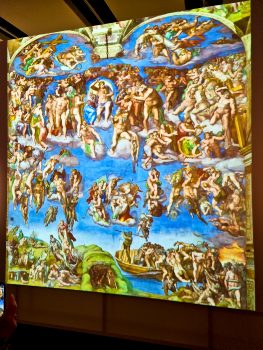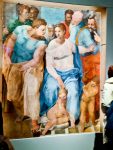Now that I’ve caught up on Newcastle, and given my sluggishness we’ve past the photo embargo time by some weeks, I can catchup with a preview visit to the British Museum‘s latest exhibition, Michelangelo: The Last Decades.

Annunciation Sketch
The Virgin, half seated
I was there as Heather’s mum occasionally gets preview tickets via her volunteer work, so she took Heather and I along on a sunny Sunday, slipping in the Museum backdoor before heading for the not quite yet signposted exhibition space at the edge of the great central reading room. The preview nature meant the exhibition was relatively quiet and it was fairly easy to see everything, though one has to question the wisdom of someone bringing young children to a preview they obviously had no interest in.

The Last Judgement
Display of the alter piece from the Sistine Chapter
Anyway, the whole thing opens with a bust of the aged Michelangelo, a friendly looking bearded face reminiscent of Father Christmas. The exhibition is focused on the period when Michelangelo was an “old man”—or at least fifty-nine—covering his move to Rome and the last thirty years of his life. He was by then a renowned artist, having sculpted David and painted the ceiling of the Sistine Chapel. On moving to Rome he was commissioned to produce his other, lesser known, work in the Chapel, The Last Judgement fresco covering the alter wall. The first proper space of the exhibition had a large projection of this fresco shining on one wall, glowing in the dim light, and giving a sense of the sheer scale of the undertaking, and number of figures involved. It also though gives a feel of the exhibition’s main failing—there just isn’t that much Michelangelo. Oh, there are sketches galore, several for various figures in that fresco for instance, but that’s in the main what they are; preparatory sketches for something else. Obviously one can’t borrow David (too early anyway), or the wall of the Sistine Chapel, but it does at times feel an exhibition of what other people did with the ageing artist’s ideas. What paintings are present are invariably by others—either in collaboration with Michelangelo or simply taking a random sketch and running with it. The only surviving large scale cartoon of his is here, but next to a frankly laughably bad painting based on it produced by some student or other.

Crucifixion
He got a bit obsessed
There are other things, such as a number of letters friends Michelangelo gained, though rarely strangely the exhibition is almost at pains to avoid speculation over just how platonic some of the artist’s feelings may have been. There’s a series of drawings of the Crucifixion—an almost obsessive repeating of the theme again and again. We’re somewhat unconvincingly told it represents Michelangelo’s growing fixation on his own mortality and spiritual well being, but perhaps he just liked the subject. Most interesting is maybe his architectural drawings, inheriting almost by default the lead role in the construction of St Peter’s Basilica. The most poignant thing is a late letter from the great man, the writing visibly spiderish and trailing over the page, as his facilities frustratingly failed him.
A partly interesting, partly frustrating exhibition then. I’d probably have been disappointed had I paid, but for free one can’t complain.

The Last Judgement

Study For The Last Judgement

One Of Many Copies Of The Last Judegement

Tiny Book

Crucifixion

Crucifixion Study

Marcello Venusti Painting

The Pieta

A Version Of The Pieta

Salt Cellar

Annunciation Sketch

Cleansing The Temple

Marcello Venusti Painting

Cartoon

Not Well Done

Hey, A Horse!

Architectural Designs

The Pieta

Crucifixion

Comments and Pings